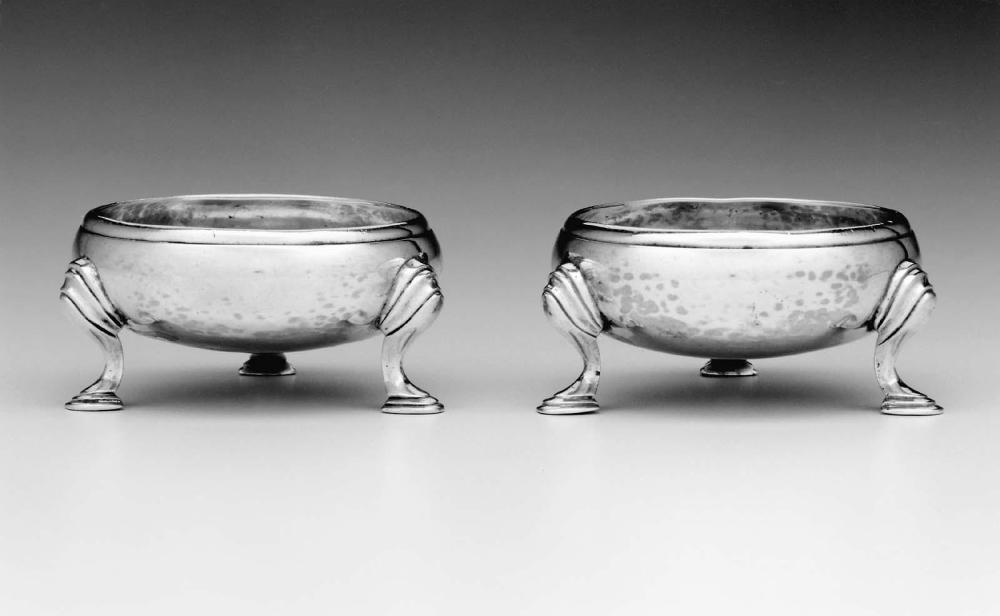Advanced Search 

Salt (one of a pair)
Benjamin Burt (American, 1729–1805)
about 1760–70
Object Place: Boston, Massachusetts
Medium/Technique
Silver
Dimensions
Overall: 3 x 5.7 cm, 0.06 kg (1 3/16 x 2 1/4 in., 0.13 lb.)
Credit Line
Gift of Rosamond G. Heard
Accession Number1991.671
NOT ON VIEW
CollectionsAmericas
ClassificationsSilver hollowware
Small footed salts such as these were commonly made during the mid-1700s; they succeeded the low circular trenchers of the early 1700s. The cast trifid-foot arrangement found on the salts is also typical of creampots and chafing dishes made during the same period. The cast cabriole legs with “molded pads” and “pad feet” described by Kathryn C. Buhler are similar to those produced by Jacob Hurd during the 1740s and 1750s and bear a close resemblance to those made by Paul Revere (cat. no. 113). The Burt salt bowls are more rounded than the broad flat-bottom salts by Hurd. Despite an active career in Boston, Benjamin Burt made few salts; only about five are known.
This text has been adapted from "Silver of the Americas, 1600-2000," edited by Jeannine Falino and Gerald W.R. Ward, published in 2008 by the MFA. Complete references can be found in that publication.
This text has been adapted from "Silver of the Americas, 1600-2000," edited by Jeannine Falino and Gerald W.R. Ward, published in 2008 by the MFA. Complete references can be found in that publication.
DescriptionThe salt is a shallow, raised, circular vessel with convex sides and scored rim, supported on three cast, cabriole-style legs with hooflike feet. Accompanying box for the salt, made in the nineteenth century, displays silk fittings with gilt block letters that read “JOSEPH WARREN TO SUSANNAH SUMNER 1771.”
Marks
"B [pellet] BURT" within a rectangle on base, over center point.
InscriptionsEngraved "R * W / to / S* S " with "to / E * S " engraved in another hand. At a later date, names were added to fill out the initials as follows: Rd * Warren / to / Sh Sumner. / to / E * S / to / Elizabeth Sumner Lewis. / to George Lewis / 1771."
ProvenanceDespite the prominence of the Boston families whose names grace these salts and their custom-made cases, the original owners of these salts remain elusive. The apparent ownership is through Susannah Stevens Sumner (1709-1733), whose sister Mary Stevens (about 1710-1800/03) was the mother of Joseph Warren (1741-1764) the patriot. Later engravings offer more secure information regarding the descendants of John Sumner (1705-1787) and Susannah Stevens (1709-1733), m. 1729, beginning with their great-granddaughter, Elizabeth Sumner Doggett (1791-1874) and Elijah Lewis (1773-1858), m. 1819;2 to their son, George Lewis (1820-1887) and Susan Minns Wheelwright (1827-1876), m. 1850; to their daughter Adeline Wheelwright Lewis (1858-1939) and John Heard (1859-1895), m. 1887;3 to their son, John Heard, Jr. (1889-1949) and his wife, the donor, Rosamond Gregor Marshall, m. 1939.
1n.a., "Genealogy of the Sumner Family," NEHGS 8 (April 1854):128j, 128m-128o; Richard Frothingham, Life and Times of Joseph Warren (Boston: Little, Brown, & Company, 1865), pp. 545-46; William Sumner Appleton, Record of the Descendants of William Sumner, of Dorchester, Mass. 1636. (Boston: David Clapp & Son, Printers, 1879), pp. 13, 31.
2Samuel Bradlee Doggett, A History of the Doggett-Daggett Family, (Boston: Press of Rockwell and Churchill, 1894), pp. 415, 440-45.
3Doggett 1894, pp. 487-88, 547-48; Edward W. Hanson, "The Heards of Ipswich, Massachusestts," (Boston: typescript, 1986), New England Historical and Genealogical Society Library, pp. 211, 244. See Jamestown 1907 pp. 35, 49, 58-9, 65, for silhouettes, a sampler, a tea caddy and additional articles owned by the Sumner family and lent by Mrs. John Heard.
1n.a., "Genealogy of the Sumner Family," NEHGS 8 (April 1854):128j, 128m-128o; Richard Frothingham, Life and Times of Joseph Warren (Boston: Little, Brown, & Company, 1865), pp. 545-46; William Sumner Appleton, Record of the Descendants of William Sumner, of Dorchester, Mass. 1636. (Boston: David Clapp & Son, Printers, 1879), pp. 13, 31.
2Samuel Bradlee Doggett, A History of the Doggett-Daggett Family, (Boston: Press of Rockwell and Churchill, 1894), pp. 415, 440-45.
3Doggett 1894, pp. 487-88, 547-48; Edward W. Hanson, "The Heards of Ipswich, Massachusestts," (Boston: typescript, 1986), New England Historical and Genealogical Society Library, pp. 211, 244. See Jamestown 1907 pp. 35, 49, 58-9, 65, for silhouettes, a sampler, a tea caddy and additional articles owned by the Sumner family and lent by Mrs. John Heard.
